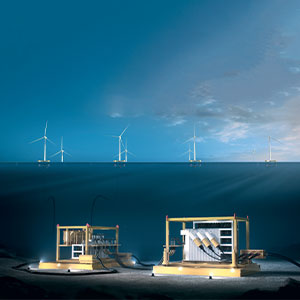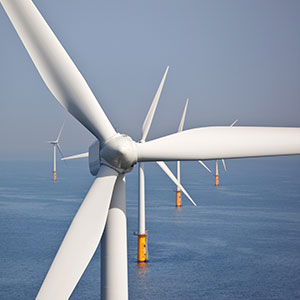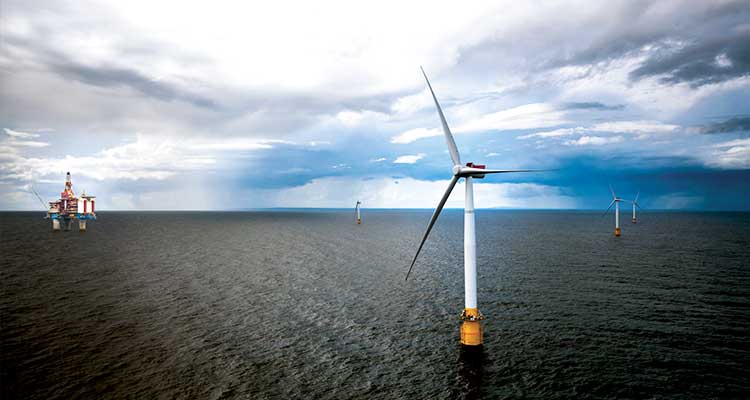Why offshore wind has the power to decarbonize all offshore operations
Two ground-breaking collaborative projects are demonstrating how offshore wind and digital and automation technologies can help reduce carbon emissions per barrel of oil/gas equivalent during offshore operations, as Per Erik Holsten explains.
It is one of the ironies of the global battle against climate change that even as nations around the world move towards a cleaner, greener energy mix, so growing demand for energy – especially in urban areas – is forcing energy companies to tap unchartered subsea reserves of fossil fuels, which are expected to account for more than two-thirds of global energy consumption until 2050.
As existing reserves deplete over time, so the value of autonomous technologies that permit deeper and farther subsea processing facilities grows. Industry 4.0 will not only help offshore operators to identify and support these new reserves; digital technologies and systems can also be used to extend the life of offshore oil and gas fields safely, efficiently, and cost-effectively, so that they can continue to supply the affordable, reliable energy the world needs as it makes the transition to renewables.
In this article, we will look at how technologies are being used to decarbonize offshore projects and help companies progress to fully automated operations, with a focus on two projects involving ABB: one helping to ensure the reliable delivery of power output from offshore wind platforms to oil and gas platforms, and a second to develop a first-of-its-kind subsea power distribution and conversion system.
Floating new ideas: Hywind Tampen
The 2022 edition of the Offshore Wind Market Report from the US Office of Energy Efficiency and Renewable Energy reports a record year for wind installation deployment in 2021, with 17,398MW of new projects commissioned, pushing global installed capacity beyond 50GW.

According to analyst, Markets and Markets, the global offshore wind market is forecast to grow from an estimated £31.8bn in 2021 to £56.8bn by 2026, at a compound annual growth rate of 12.3 percent.
The environmental benefits of offshore wind extend beyond boosting the amount of clean energy in the overall mix. In the case of Hywind Tampen in the Norwegian North Sea – the world’s first floating wind farm to power offshore oil and gas platforms – offshore wind generation is also being used to decarbonize hydrocarbon projects. Supplying electricity to the Snorre and Gullfaks oil and gas fields reduces the emissions per barrel of oil produced and protects operator Equinor’s license to operate.
In total, 88MW of clean power will be supplied to the two offshore platforms. Flexible onboard gas power will balance production with how much wind power is available and it is estimated that wind power will save as much as 35 percent in terms of power consumption and will cut CO2 emissions from the fields by about 200,200 tonnes per year.
The project is unique in that it connects an offshore wind farm to an offshore platform, and not to an onshore power grid. ABB’s scope of work includes a control system, a safety system at Gullfaks and a modified power management system. The latter automation solution will control the power generation from the wind farms so they can be connected to the oil and gas operations at Gullfaks.
ABB’s involvement in the early phase (concept design, FEED and execution) of such projects allows the company to help clients meet sustainability targets and operate facilities at optimum efficiency.
Sea change: pioneering subsea power systems
As we mentioned at the outset, more oil and gas operators are looking to develop reserves in remote subsea environments. Not only do these types of facilities do away with the need for heavy fixed or floating installations on the surface, they are also a more efficient way to produce oil and gas from reservoirs far from shore. This industry trend means that technology advancements that can help facilitate the construction of fully functional infrastructure on the seabed are now at a premium.
ABB’s pioneering subsea power distribution and conversion system – developed in collaboration with Equinor, Total and Chevron – supplies power directly to underwater pumps and compressors near the reservoir via a sleek cable that extends up to 600km and goes as deep as 3000m, and has the potential to allow offshore oil and gas operators to eliminate the surface platform altogether.

Generating power from the shore in this way, as opposed to getting electricity from gas turbines on fixed floating platforms or ships, results in energy and cost savings and of course, significantly reduced carbon emissions.
The environmental benefits don’t end there: the unique subsea electrical system can also be linked to renewable power sources like offshore wind and hydropower, which could help operators reduce their carbon footprint even further as well as create new possibilities for the future energy transition.
Industry 4.0 and offshore wind
In conclusion, technologies like those outlined above, when deployed strategically in partnership with a technology provider with deep domain expertise, can help integrate renewables such as offshore wind into the energy mix as well as reduce CO2 emissions per barrel of oil/gas equivalent.
Not only that, but they can also enhance safety, drive productivity, ensure reliability, increase efficiency and streamline performance for offshore energy producers as they embrace industry 4.0 solutions.
At Hywind Tampen, for example, operators will gain invaluable experience of how to run offshore oil and gas operations using an intermittent power supply – i.e when the wind isn’t blowing – while also helping keep facilities cyber-secure. In this way, offshore wind can continue to fulfil its potential, both as a renewable energy source in its own right, and as the power behind oil and gas operations aiming to minimize their emissions on the road to net zero.
For a list of the sources used in this article, please contact the editor.
Per Erik Holsten is head of ABB Energy Industries Northern Europe. ABB Energy Industries is enabling safe, smart, and sustainable projects and operations for businesses across oil, gas, chemicals, power generation, life sciences and water sectors. Driving integrated solutions that automate, digitalize, and electrify industry, it connects its people and technology to help customers adapt and succeed. Its technologies and solutions are designed to create value, improving operational efficiency and productivity, helping to lower carbon emission, enhance safety and minimize risk.
